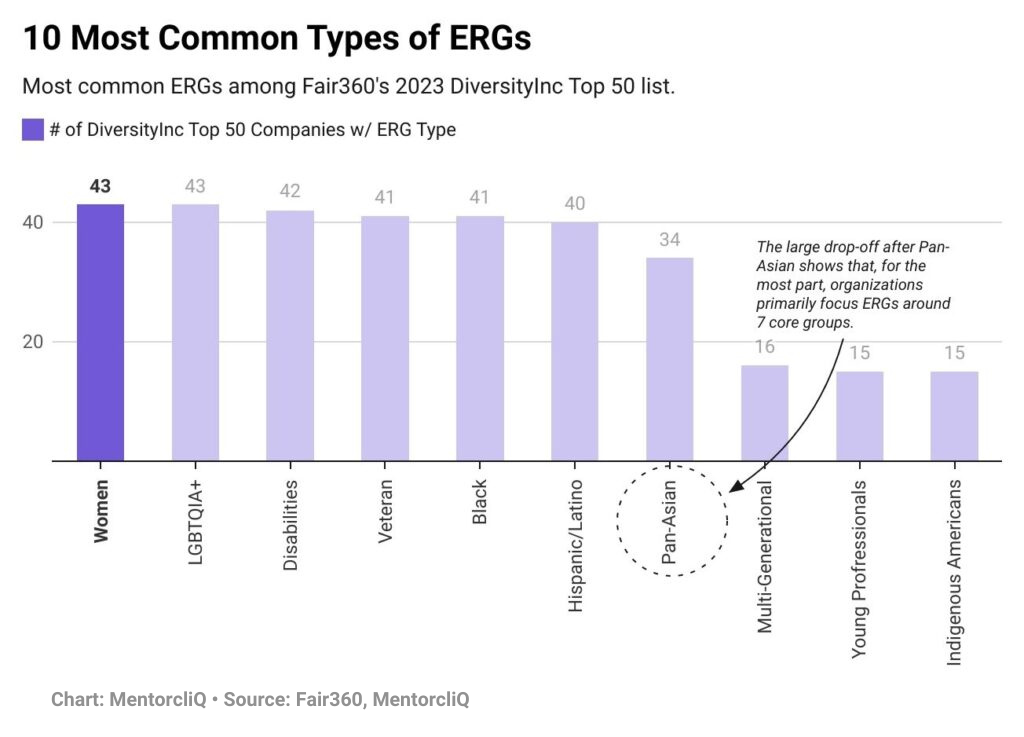When Xerox pioneered the National Black Employee Caucus—the first corporate employee resource group (ERG) in the 1960s—it was responding positively to existing racial tensions, and boldly pushing back against cultural norms. By providing safe spaces for black employees where they could network and develop without fear of discrimination, the company made a bold and risky venture that ultimately paid off in the end. This marked a significant milestone in corporate history and diversity efforts and set a precedent for other organizations to follow.
Today, Employee Resource Groups (ERGs) are widely recognized as valuable assets within companies, giving them a competitive edge in various ways. ERGs facilitate diversity and inclusion, attract and retain talents, and assist in market insight and understanding diverse customer bases. Not only do ERGs foster a more inclusive and supportive workplace, but these groups also provide tangible business benefits, making them essential in the modern corporate landscape.
In this post, we’re going to outline some key benefits of ERGs to both employees and employers.
Take It With You:
Learn How ESPN Combined ERGs + Mentoring to Boost Culture and Employee Retention
What Are Employee Resource Groups?
Employee Resource Groups (ERGs), also known as Employee Networks or Affinity Groups, are usually voluntary, employee-led groups that aim to foster a diverse, inclusive workplace aligned with the organizations they serve. These groups are typically formed around common interests, backgrounds, or demographic factors such as gender, race, ethnicity, or sexual orientation.
After examining Fair360’s Top 50 Companies for Diversity, we found that the most common types of ERGs provide community and space for the following affinities:
- Women
- LGBTQIA+
- Disabilities
- Veteran
- Black
- Hispanic/Latino
- Pan-Asian
- Multi-Generational
- Young Professionals
- Indigenous Americans

While “10” is about average, there’s no limit to how many ERGs companies can have. Some companies may have just 1 ERG, for example, while others (like Target) break the mold with well over a dozen official groups and many other unofficial groups.
How do companies decide on what ERGs to create?
While there’s generally no limitation to the number of ERGs a company has, most companies try to consider their employees’ needs before launching ERGs. The criteria most commonly considered before launching ERGs include:
- The size of the company
- Internal diversity metrics
- Employee interest
- Available DEI budget
Larger companies often have more ERGs due to a greater number of employees and more resources to support these groups. However, smaller companies can also benefit from ERGs, even if they have fewer groups.
Interestingly, some companies establish multiple programs or initiatives within a single ERG audience, catering to the unique aspects or subgroups within a broader category. Google, for example, has over 16 employee resource groups, and among those is Africans@Google, which is part of a wider Black Googler Network.
We’ve already covered in greater detail what ERGs are. If you haven’t accessed that page yet, we bring some clarity to the differences between ERGs and BRGs (and which one you should go for), the purposes of ERGs, how to start an employee resource group and more!
Why Are Employee Resource Groups Important?
The importance of ERGs lies in their ability to bridge the gap between diverse groups of employees and the broader organizational goals. ERGs create a platform where underrepresented voices can be heard and where unique perspectives are valued. This way, marginalized or underrepresented groups can voice their concerns, share their experiences, and contribute their unique perspectives. This inclusivity not only benefits the members of these groups but also enriches the organizational culture, leading to a more understanding, respectful, and collaborative workplace.
ERG Benefits to Employees
Employee resource groups are designed around employees’ need for connection across different affinities. Whether you call them business resource groups (BRGs), affinity groups, or another term, as long as employees are connecting in dedicated groups along common interests, the same purpose is served. The benefits can be felt across several different avenues, as well, including leadership development, skill development, employee connection and culture building, and spaces that promote psychological safety, among other benefits.
Cultivate leadership and skill development
ERGs provide opportunities for leadership and skill development outside of an employee’s regular job responsibilities. Members can take on leadership roles within the group and gain valuable experience that can be beneficial for career advancement.
For example, an employee in a junior role can join an employee resource group and take on a project management role within the group. They can hone skills like leadership, communication, and strategic planning. This experience can be highlighted in their professional portfolio, aiding in future promotions.
Facilitate connections
Employees can connect with colleagues across different departments and levels within the organization. This networking can lead to mentorship opportunities and help in career progression. Through ERG meetings and events, an employee connects with senior staff from another department, leading to a mentoring relationship. This connection provides insights into career advancement opportunities within the organization.
Provide a safe and inclusive space
ERGs offer a space where employees can find support and a sense of belonging. This is particularly beneficial for individuals from underrepresented groups as affinity groups help reduce feelings of isolation at work and create a more inclusive workplace culture.
Educate members and the broader organization
These groups often educate their ERG members and the broader organization about different cultures, lifestyles, and experiences. An employee resource group can organize cultural awareness workshops that educate other employees about different customs and traditions. This leads to a more respectful and understanding work environment, which, in turn, fosters better team collaboration.
Boost job satisfaction and morale
When employees participate in an employee resource group, it helps them feel more valued and heard within the company. This increased engagement results in higher job satisfaction and employee morale.
ERG Benefits to Employers
Many executive leaders have unfortunately and incorrectly viewed employee resource groups as “social clubs.” This mischaracterization has often led to little to no executive-level support for ERGs beyond allowing them to exist. However, ERGs can have wide and positive impacts on key business objectives, especially when combined with a mentoring component.
In our 2024 Mentoring Impact Report, we found that 100% of Fair360’s Top Companies for Diversity had both ERGs and Mentoring. And in our upcoming Benchmarketing Report, we found that employees who are in both mentoring programs and in ERGs have the lowest reported turnover rates compared to their peers.
Introduce diverse perspectives
ERGs bring diverse perspectives to the table, which can be invaluable in decision-making processes, leading to more innovative and inclusive solutions. For instance, ERG members can provide feedback on a new product, offering insights that reflect a wider range of customer experiences. This leads to modifications that make the product more inclusive and appealing to a broader audience.
Attract talents and improve employee retention
Companies with active ERGs are often more attractive to prospective employees. A prospective employee chooses a company over competitors because of its active and visible ERGs, which indicates a commitment to diversity and inclusion. Current employees, feeling supported by these groups, are more likely to remain with the company. In fact, about 3 in 10 US workers say it’s extremely or very important to them to work somewhere with a mix of employees of different races and ethnicities (32%) or ages (28%).
Garner critical consumer and market insights
An employee resource group comprised of ERG members from a specific demographic can provide critical insights into consumer preferences within that group. This aids the company in tailoring marketing strategies to reach this audience more effectively.
Strengthen the company’s reputation
Companies with strong ERGs are often seen as more progressive and socially responsible. Not only does it enhance the company’s reputation among consumers, but it’s also recognized in industry awards and publications.
Foster a culture of inclusivity and respect
The presence of multiple ERGs contributes to a culture of inclusivity and respect, making the workplace more welcoming. This positive work environment boosts overall employee engagement and productivity.
Reap the Benefits of Employee Resource Groups for Diverse Workforce
The evolution of Employee Resource Groups (ERGs) from their inception at Xerox to their current widespread implementation underscores their critical role in shaping inclusive workplaces. Not only do ERGs bolster diversity and inclusion, but they also contribute significantly to professional development, cultural awareness, and organizational success. As the workplace continues to evolve, embracing the unique perspectives and experiences of diverse employee groups becomes increasingly important.
Integrating tools like CommunityCliQ employee community software can amplify these efforts, providing a streamlined, efficient platform for managing and enhancing the effectiveness of ERGs. With purpose-built technology for ERGs, organizations can ensure that their employee resource groups are not just supportive networks but also key contributors to both individual growth and overall corporate strategy. This synergy between technology and human-centric groups offers a promising path forward for companies seeking to harness the full potential of their diverse workforce.
ERGs + Mentoring boost Retention and Engagement. Book a demo to learn how!
ERG Benefits FAQs
What do employee resource groups do?
ERG activities and functions can vary widely based on their focuses and objectives. However, they generally host events, assist with recruitment and engagement plans, serve as advisors for business activities and decisions, advocate for social change, and get involved in community service.
What is the best reason for how employee resource groups promote diversity within an organization?
They promote belonging among employees with common characteristics. By creating a space where employees with common characteristics, such as gender, ethnicity, or interests, can come together, ERGs encourage an environment where diverse perspectives are shared and valued. This sense of belonging not only supports individuals from various backgrounds but also enhances the overall inclusivity within the organization.
How to evaluate employee resource groups?
You can evaluate ERGs by assessing their impact on workplace diversity, inclusivity, and employee engagement. This can be done through surveys to gauge member satisfaction and feedback, analyze the ERG’s influence on company policies and culture, measure participation rates and diversity of membership, and observe changes in the organization’s overall performance and employee morale. The effectiveness of ERGs is also reflected in their ability to foster professional development opportunities and contribute to positive changes in the workplace.
When do employee resource groups meet?
ERG members typically meet during regular working hours, either monthly or quarterly, to ensure broad participation. Meetings can also be scheduled to align with specific projects or events, and the frequency can vary based on the group’s objectives and member availability.
Who leads employee resource groups?
ERGs are usually led by employees who volunteer or are elected by their peers, often with the support of a senior executive sponsor. ERG leaders are typically passionate about the group’s focus area and possess skills in organizing, motivating, and advocating for the group’s goals within the broader framework of the organization’s objectives.




